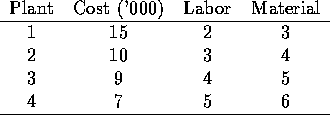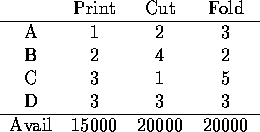
Tucker Inc. needs to produce 1000 Tucker automobiles. The company has four production plants. Due to differing workforces, technological advances, and so on, the plants differ in the cost of producing each car. They also use a different amount of labor and raw material at each. This is summarized in the following table:

The labor contract signed requires at least 400 cars to be produced at plant 3; there are 3300 hours of labor and 4000 units of material that can be allocated to the four plants.
Attached is a formulation and LINDO output for this problem. Here are some questions to be answered:
MIN 15 X1 + 10 X2 + 9 X3 + 7 X4
SUBJECT TO
2) X1 + X2 + X3 + X4 = 1000
3) X3 >= 400
4) 2 X1 + 3 X2 + 4 X3 + 5 X4 <= 3300
5) 3 X1 + 4 X2 + 5 X3 + 6 X4 <= 4000
END
LP OPTIMUM FOUND AT STEP 3
OBJECTIVE FUNCTION VALUE
1) 11600.000
VARIABLE VALUE REDUCED COST
X1 400.000000 0.000000
X2 200.000000 0.000000
X3 400.000000 0.000000
X4 0.000000 7.000000
ROW SLACK OR SURPLUS DUAL PRICES
2) 0.000000 -30.000000
3) 0.000000 -4.000000
4) 300.000000 0.000000
5) 0.000000 5.000000
NO. ITERATIONS= 3
RANGES IN WHICH THE BASIS IS UNCHANGED:
OBJ COEFFICIENT RANGES
VARIABLE CURRENT ALLOWABLE ALLOWABLE
COEF INCREASE DECREASE
X1 15.000000 INFINITY 3.500000
X2 10.000000 2.000000 INFINITY
X3 9.000000 INFINITY 4.000000
X4 7.000000 INFINITY 7.000000
RIGHTHAND SIDE RANGES
ROW CURRENT ALLOWABLE ALLOWABLE
RHS INCREASE DECREASE
2 1000.000000 66.666664 100.000000
3 400.000000 100.000000 400.000000
4 3300.000000 INFINITY 300.000000
5 4000.000000 300.000000 200.000000
Carla Lee, a current MBA student, decides to spend her summer designing and marketing bicycling maps of Western Pennsylvania. She has designed 4 maps, corresponding to four quandrants around Pittsburgh. The maps differ in size, colors used, and complexity of the topographical relief (the maps are actually 3-dimensional, showing hills and valleys). She has retained a printer to produce the maps. Each map must be printed, cut, and folded. The time (in minutes) to do this for the four types of maps is:

The printer has a limited amount of time in his schedule, as noted in the table.
The profit per map, based on the projected selling price minus printers cost and other variable cost, comes out to approximately $1 for A and B and $2 for C and D. In order to have a sufficiently nice display, at least 1000 of each type must be produced.
Attached is the formulation and LINDO output. Here are some questions to answer:
MAX A + B + 2 C + 2 D
SUBJECT TO
2) A + 2 B + 3 C + 3 D <= 15000
3) 2 A + 4 B + C + 3 D <= 20000
4) 3 A + 2 B + 5 C + 3 D <= 20000
5) A >= 1000
6) B >= 1000
7) C >= 1000
8) D >= 1000
END
LP OPTIMUM FOUND AT STEP 8
OBJECTIVE FUNCTION VALUE
1) 10166.667
VARIABLE VALUE REDUCED COST
A 1500.000000 0.000000
B 1000.000000 0.000000
C 1000.000000 0.000000
D 2833.333252 0.000000
ROW SLACK OR SURPLUS DUAL PRICES
2) 0.000000 0.500000
3) 3500.000000 0.000000
4) 0.000000 0.166667
5) 500.000000 0.000000
6) 0.000000 -0.333333
7) 0.000000 -0.333333
8) 1833.333374 0.000000
NO. ITERATIONS= 8
RANGES IN WHICH THE BASIS IS UNCHANGED:
OBJ COEFFICIENT RANGES
VARIABLE CURRENT ALLOWABLE ALLOWABLE
COEF INCREASE DECREASE
A 1.000000 1.000000 0.333333
B 1.000000 0.333333 INFINITY
C 2.000000 0.333333 INFINITY
D 2.000000 1.000000 0.500000
RIGHTHAND SIDE RANGES
ROW CURRENT ALLOWABLE ALLOWABLE
RHS INCREASE DECREASE
2 15000.000000 1000.000000 3666.666748
3 20000.000000 INFINITY 3500.000000
4 20000.000000 7000.000000 1000.000000
5 1000.000000 500.000000 INFINITY
6 1000.000000 1750.000000 1000.000000
7 1000.000000 500.000000 1000.000000
8 1000.000000 1833.333374 INFINITY